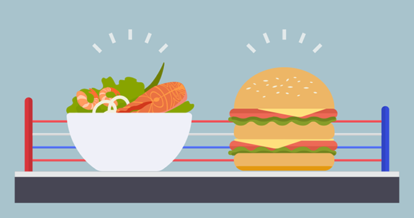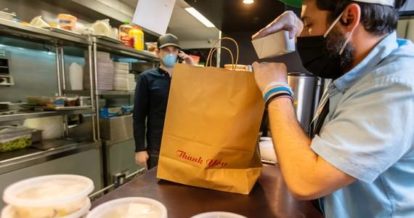If you’ve been pondering the fast casual vs fast food restaurant distinction, you’re not alone. These two business models sound similar and operate similarly. However, there are key differences between them.
While customers count on fast food franchise titans like McDonald’s and KFC for quick meals at incredibly low prices, customers opt for fast casual dining when they want the speed of a quick service restaurant (QSR), but the quality of a full service restaurant (FSR) meal.
However, the COVID-19 pandemic has blurred the lines between these two QSR models. Traditionally, fast food restaurants have been known for drive-thrus and fast casual for online ordering. Now these two QSR concepts are offering their customers both convenient options.
For those interested in opening a new QSR or making changes to an existing venue, you might be wondering: What are the distinctions between these QSR styles?
In this guide to fast casual vs fast food restaurants, you’ll learn the differences, including:
- An overview of the differences between fast casual and fast food establishments
- Key characteristics of fast food restaurants
- Key characteristics of fast casual dining
- The technology required to run each kind of QSR
- The benefits of both business models
Fast Casual vs Fast Food: An Overview
When you think of fast food restaurants, you probably think of big-name chains like McDonald’s, Burger King, and Taco Bell. They emphasize off-premise dining and usually offer drive-thrus. They largely focus on value and speed over quality. Their menus are usually simple and not as customizable as those of fast casual restaurants.
On the other hand, Chipotle, Panera, and Sweetgreen are examples of fast casual restaurants. Their main distinctions are a higher price point in exchange for better quality food, more customizations, and an elevated on-premise dining experience.
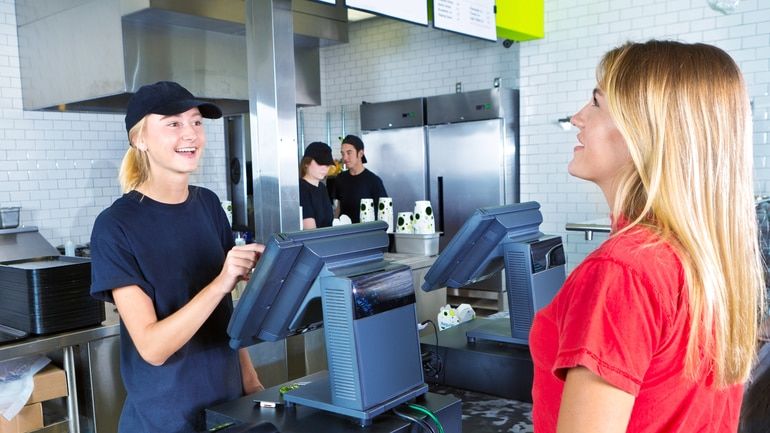
Fast Food Restaurants
Now that we’ve covered the main differences between fast food and fast casual dining, let’s dive into specifics.
First up in the fast casual vs fast food battle, we cover everything you need to know about what makes fast food restaurants unique.
Typical Characteristics of a Fast Food Restaurant
These are the key components of the fast food experience:
- Self-service: The service at fast food restaurants is very simple – it’s nearly all up to the customer. From placing the order, to picking it up, everything except cooking the actual food is done by fast food patrons.
- Limited on-premise dining: The emphasis here is on taking the food out for off-premise dining, or eating it quickly, so fast food restaurants typically don’t have large or heavily decorated dining rooms.
- Simple menus: Fast food restaurants offer simple, easy-to-assemble foods always made the same way to increase speed.
- Don’t serve alcohol: Fast food establishments are less likely than fast casual restaurants to serve alcohol, although Taco Bell now offers booze at some locations.
- Value: The average check size at a fast food restaurant is just $5 – a major draw for cost-conscious customers.
- Drive-thru: Many fast food restaurants offer drive-thru ordering for added customer convenience.
- Open late: Fast food spots are typically open very late, and sometimes even 24/7.
- Consistency: Fast food spots aim to offer the same experience across all locations. For instance, a Big Mac in New York will taste the same as a Big Mac in Italy!
Those are just some of the features of fast food restaurants that make them appealing to customers and the restaurateurs who run them.
The Fast Food Restaurant Customer Experience
The counter service restaurant or fast food customer experience begins with one of several ordering touchpoints: a drive-thru, an in-store counter or self-ordering kiosk for in-person ordering, or a web browser or app for off-premise ordering.
For instance, at Heart Beet Kitchen, an independent fast food restaurant in Ocean City, NJ, customers order from the walk-up window or the interior counter. Alternatively, customers can place orders through the restaurant’s online ordering platform. When orders are ready, staff members call out customers’ names to hand off meals. Patrons can then enjoy their meals on- or off-site.
Technology in a Fast Food Restaurant
While each fast food restaurant is a little bit different, these are the technologies that fast food restaurants generally rely on:
- POS: Fast food restaurants use point of sale (POS) systems for taking orders and sending them to the kitchen, managing inventory, processing payments, analyzing sales data, and so much more.
- Online ordering and delivery: Online ordering technology has become increasingly popular at fast food restaurants since the onset of COVID-19, as consumers are looking for contactless ways to enjoy their favorite foods. This software lets restaurants accept orders directly through their own website or app for a seamless ordering experience. And when the online ordering software is integrated with your POS, the tickets go directly to the kitchen to make fulfilling orders quick and easy.
- Loyalty: Loyalty programs are replacing punch cards and helping fast food restaurants drive repeat business in a big way. According to Harvard Business Review, increasing customer loyalty by just 5% can result in up to a 95% increase in profits.
- Self-ordering kiosks: At some fast food establishments self-ordering kiosks have been added to help reduce labor costs and shorten queues. McDonald’s, for example, is adding such machines to 4,000 stores annually. In the wake of the COVID-19 pandemic, self-ordering kiosks have become even more valuable for fast food restaurants because they reduce face-to-face contact during the ordering process.
- Kitchen Display System (KDS): Fast food restaurants require a high-level of speed and efficiency in the kitchen. A KDS helps to keep things organized by displaying these orders for the back-of-house staff to prepare as soon as they are entered into the POS – no need to wait for front-of-house staff to bring back paper tickets.
These kinds of advanced technological solutions make it possible for fast food restaurants to offer customers consistent meals at unbeatable speeds and prices.
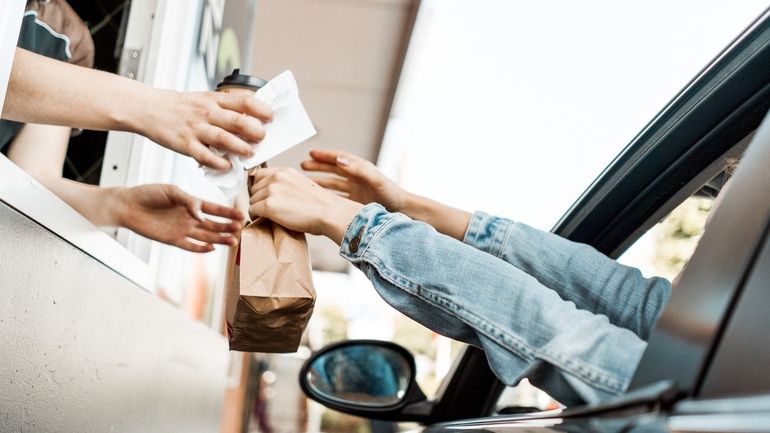
Benefits of Running a Fast Food Restaurant
Restaurateurs choose to open fast food concepts because of their many benefits, such as:
- Cheaper food costs: Customers go to fast food restaurants because they want consistency, speed, and value. Quality isn’t the main concern, so you can buy cheaper ingredients than if you ran a fast casual restaurant. If the average check size at a fast food joint is about $5 and the food cost percentage is about 30%, then the ingredients cost only $1.50. That’s a 70% profit margin!
- Convenience is a big draw for customers: Customers value satisfying their hunger without breaking the bank or running late to a meeting. Fast food restaurants are fine-tuned for speed and efficiency, making convenience a major selling point for customers.
- Cheaper labor costs: The more in-depth the level of service, the more expensive the labor costs. Fast food restaurants typically spend less on labor than other types of restaurants because the level of service provided is relatively minimal.
- Cheaper rent: Because customers don’t often dine-in at fast food restaurants, these establishments usually require smaller footprints than fast casual restaurants. Fast food restaurants, therefore, don’t have to spend as much on rent as other restaurants.
- It’s easy to find talent: Because much of fast food cooking involves heating ingredients and assembling simple dishes, you don’t necessarily need highly specialized staff. In most cases, this makes it easier to find new talent.
These perks are why there are almost 200,000 fast food restaurants in the United States alone.
Fast Casual Restaurants
Now that you’re an expert on fast food restaurants, let’s cover what makes fast casual dining distinct in the fast casual vs fast food restaurant debate.
Typical Characteristics of a Fast Casual Restaurant
These are the key traits that you’ll find at a fast casual establishment:
- Limited service or self-service: While fast food restaurants only offer self-service, some fast casual restaurants also offer limited service, which involves bringing food directly to the customer’s table.
- Emphasis on dining in: While fast casual establishments offer food to go, their customers tend to dine in much more than fast food patrons. Fast casual restaurants, therefore, put more effort into the ambiance of their dining rooms. For example, most Chipotle dining rooms are decorated with wood-and-metal artworks inspired by Mayan iconography.
- Better quality food: Fast casual restaurant customers expect higher quality ingredients and are willing to pay for them. A fast casual meal cost less than a meal at an FSR, but more than at a fast food restaurant. The average check size at a fast casual restaurant is $12, compared to $5 at a fast food place.
- Customizable meal options: Customization is at the forefront of the fast casual movement. Restaurants like Chipotle and Sweetgreen bring the back of the house to the front of the house by displaying ingredients to customers in buffet-style serving cases. Customers can point to the ingredients they want in their dishes, or choose pre-made combinations from the menu.
- Some serve alcohol: Fast casual spots are increasingly adding alcoholic beverages to their offerings. Chipotle, for example, serves margaritas in half of its stores.
- Emphasis on design: Fast casual restaurants usually have upscale, unique, or highly developed decor. Branding and design are important because of the emphasis on on-premise dining.
- Usually no drive-thru: Though there are some exceptions, fast casual restaurants usually don’t have drive-thru windows like fast food restaurants do. However, more fast casual spots are adding drive-thru ordering systems due to some of the dining restrictions of the COVID-19 pandemic.
- Not open as late as fast food restaurants: You typically won’t find fast casual restaurants that are open 24/7.
While there are some exceptions to the above, these are some of the defining features that set casual dining apart in the fast casual vs fast food debate.
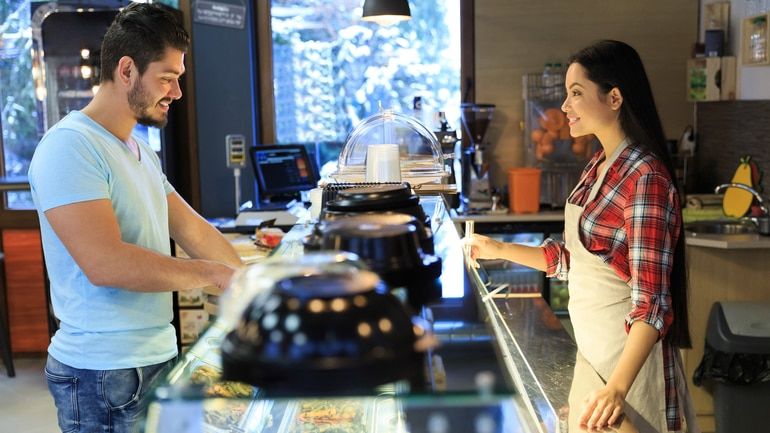
The Fast Casual Restaurant Customer Experience
The fast casual dining experience begins either at the restaurant or online.
If customers want to place an on-premise order, they do so with a staff member or through a self-ordering kiosk. At restaurants that offer make-your-own dish options, customers point to ingredients they want and staff build the order for them. Sometimes the meal is brought to the customer’s table, and sometimes the customer picks it up after paying. In some cases, the restaurant may even have its own mobile app for seamless online ordering.
For example, at Honeygrow – a tech-savvy, independently-owned fast casual chain based in Philadelphia – walk-in customers place orders through self-ordering kiosks located in the restaurant. The kiosks let customers build their own stir fry dishes and salads, or choose from pre-selected combinations from the menu, making Honeygrow a top pick for what to eat in Philadelphia. Customers pay for their meals through the kiosks, and then collect when they are ready. Honeygrow’s customers can also place orders online for pickup or delivery, throw a browser or through the restaurant’s app.
Technology in a Fast Casual Restaurant
Most QSRs, including fast casual establishments, rely on these technologies to make operations efficient:
- POS: The quick service POS system processes orders, collects business data, processes payments, tracks inventory, and more.
- Online ordering and delivery: Online ordering software enables customers to place orders for pickup or delivery directly from a restaurant’s website. Some fast casual restaurants may also use third-party apps like Uber Eats and DoorDash to facilitate delivery orders.
- Customer facing display systems: Some fast casual restaurants use customer displays to show customers their orders as the information is inputted into the POS. These displays reduce errors and highlight promotions to drive repeat business.
- Loyalty: Loyalty programs reward customers for frequenting the restaurant and help to boost customer retention.
Among today’s tech-savvy diners, operating a fast casual dining concept without these tools would prove difficult.
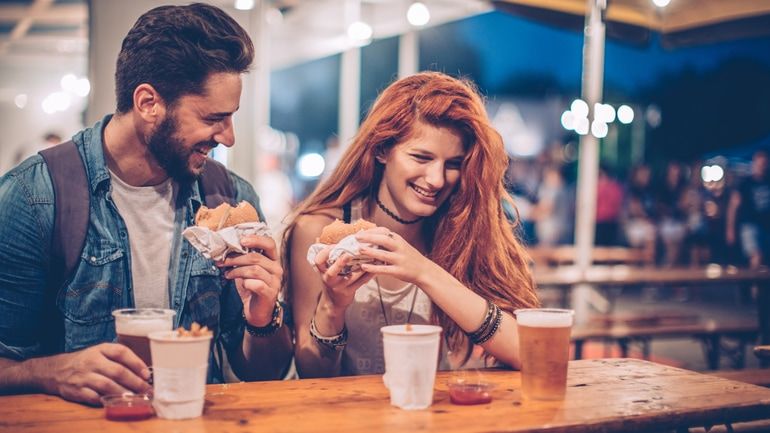
Benefits of Running a Fast Casual Restaurant
Considering opening a fast casual restaurant? These are some of the perks of running one:
- Higher average check prices: The average check size for a fast casual meal is about $12 – that’s seven dollars more than the price of a standard fast food check.
- Appeal to choosy customers: Customers who are health-conscious, sustainability-conscious, or are following a certain diet are frequently drawn to fast casual restaurants, which usually emphasize health or sustainability over bargain prices. Fast casual restaurants tend to be more mindful of offering and highlighting vegan, vegetarian, gluten-free, or dairy-free options on their menus, which is a selling point for some customers. The inclusion of healthier menu alternatives also allows fast casuals to market themselves as better than fast food – and consumers are eating it up. According to reports, 73% of millennials and 62% of Gen Zers would pay more for higher quality, sustainable food.
- An elevated level of service attracts customers: Fast casual restaurants offer an elevated level of service that fast food restaurants can’t compete with. Panera, for example, gives their patrons the option of being served tableside. This elevated, hybrid service model appeals to customers who want that catered experience.
- Increased revenue through off-premise sales: Fast casual restaurants are leading the way with mobile ordering solutions in the QSR sector. When you make it easy for customers to place orders from anywhere, you can serve more people than could queue up inside your restaurant, ultimately leading to more revenue coming in.
As you can gather from the above, there are plenty of good (and lucrative) reasons to run a fast casual restaurant.
Fast Casual vs Fast Food: The Bottom Line
The restaurant industry is constantly evolving and so are the different types of restaurants. While fast food restaurants may be the original QSR concept, fast casual spots are making inroads in this sector. Whichever service model you currently operate, or eventually choose to operate, you’ll need technology to run your restaurant smoothly.
Free job application template for restaurants
Sign up for our free weekly TouchBistro Newsletter

